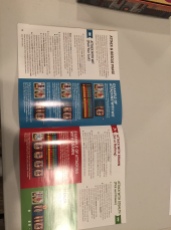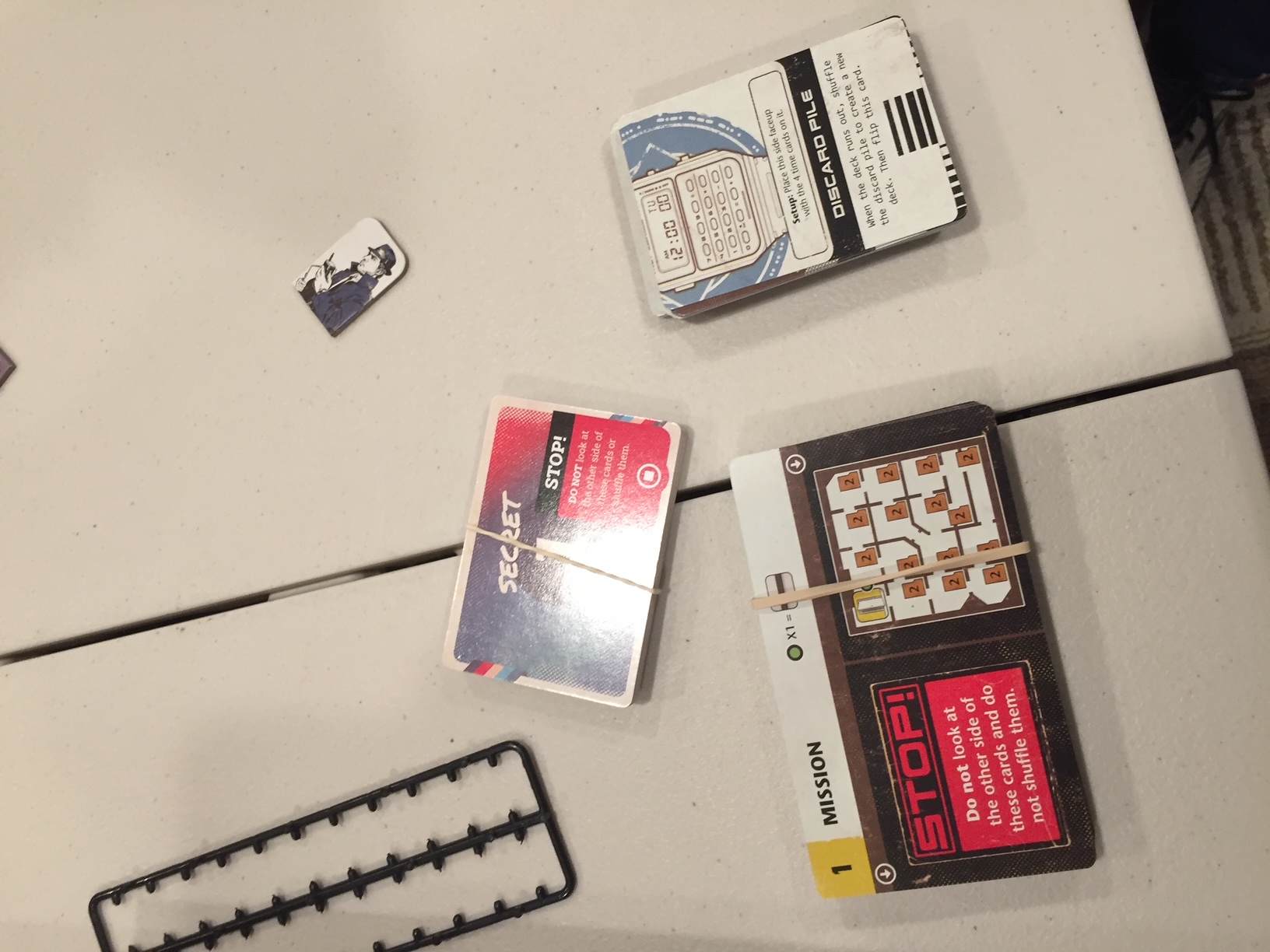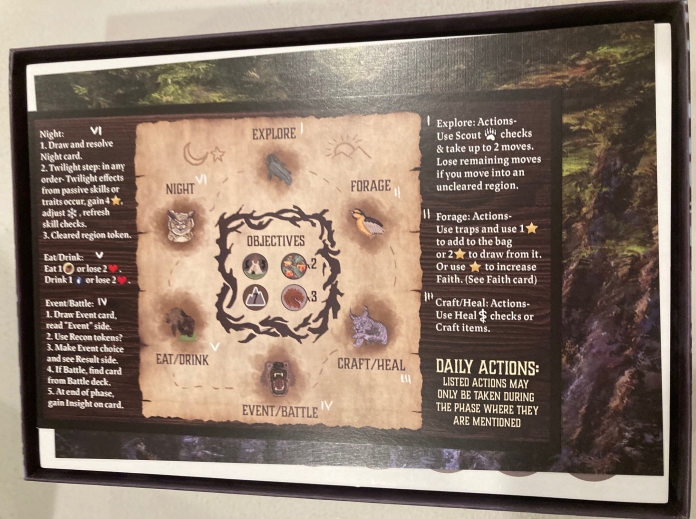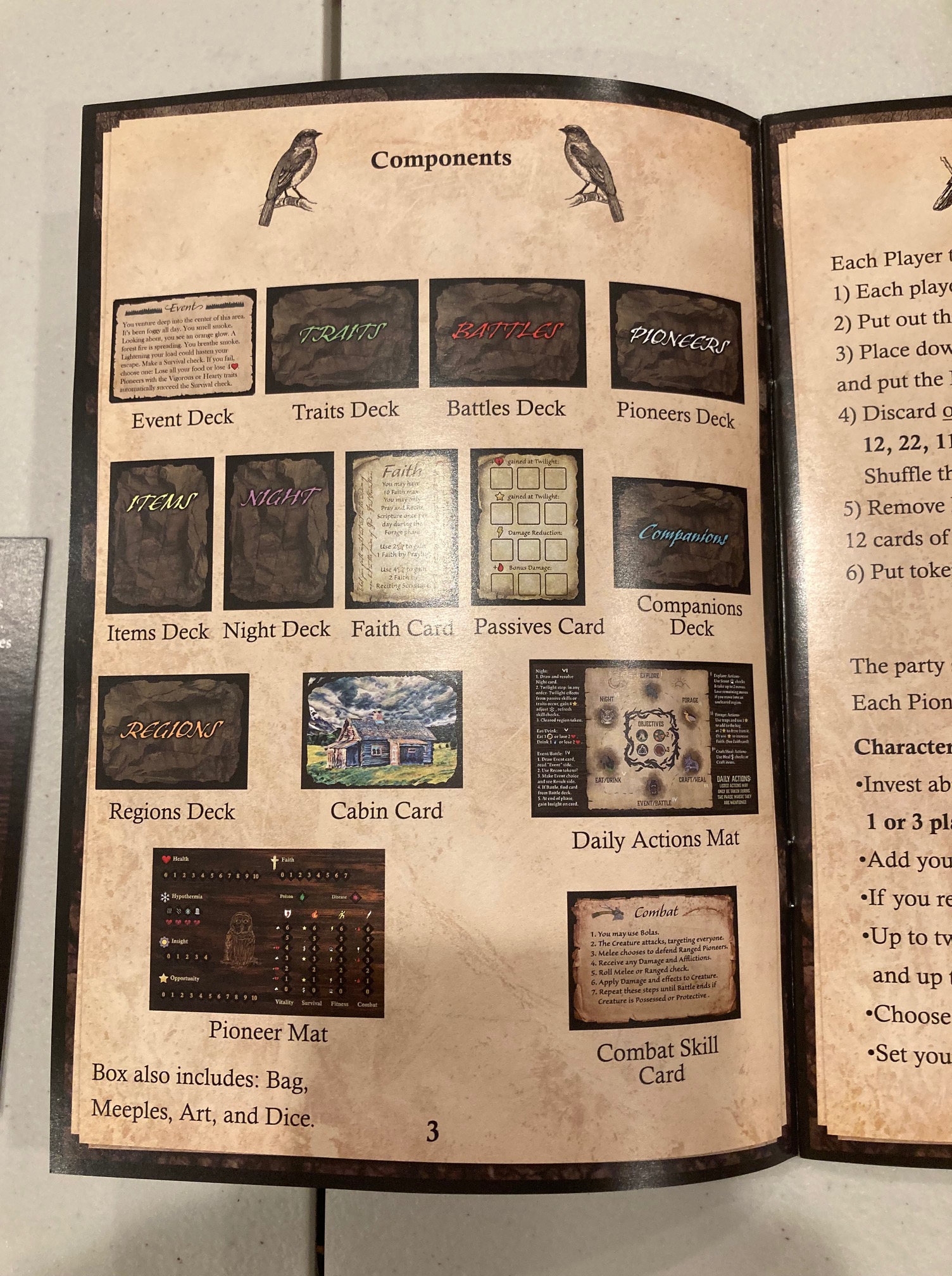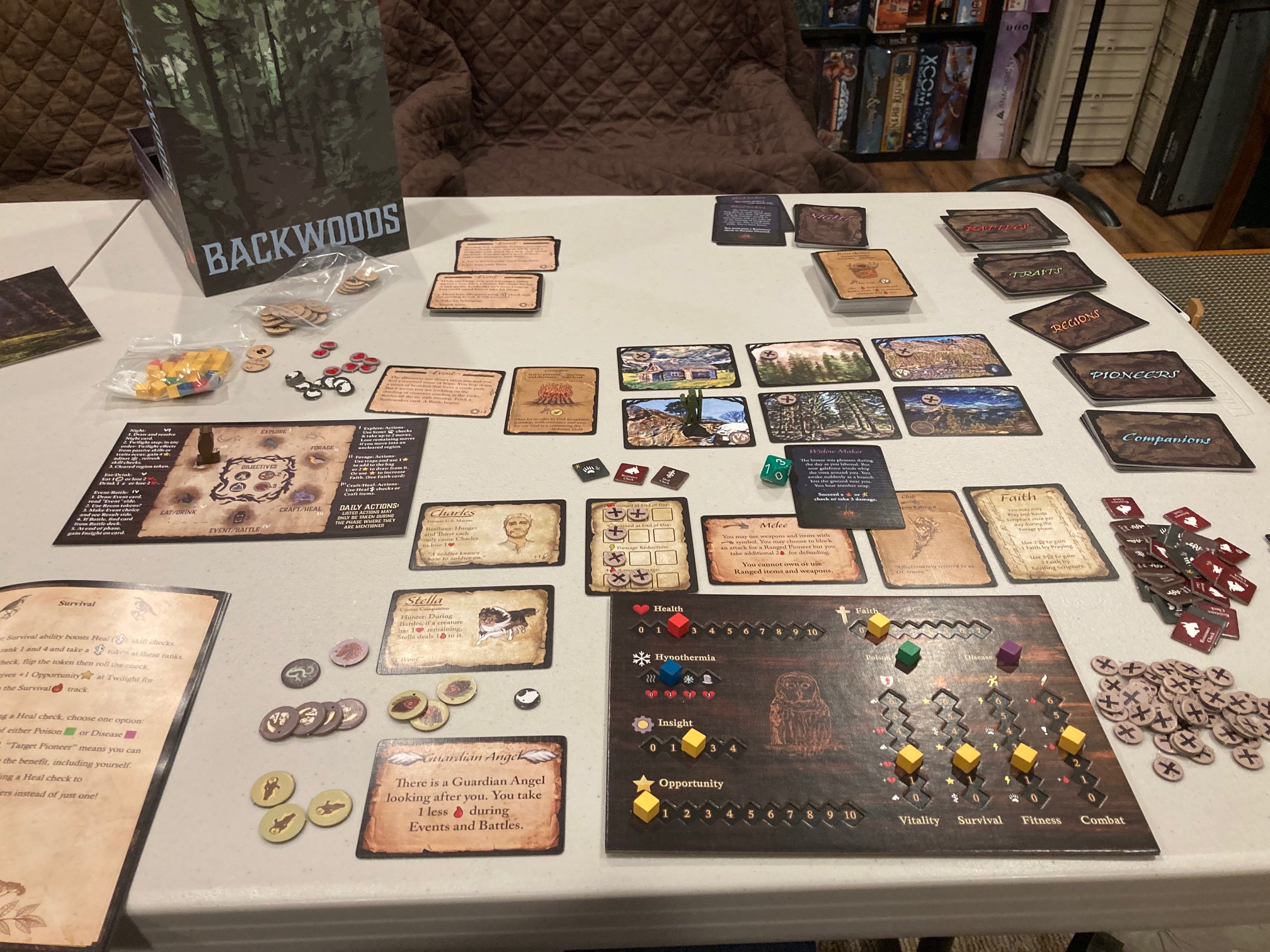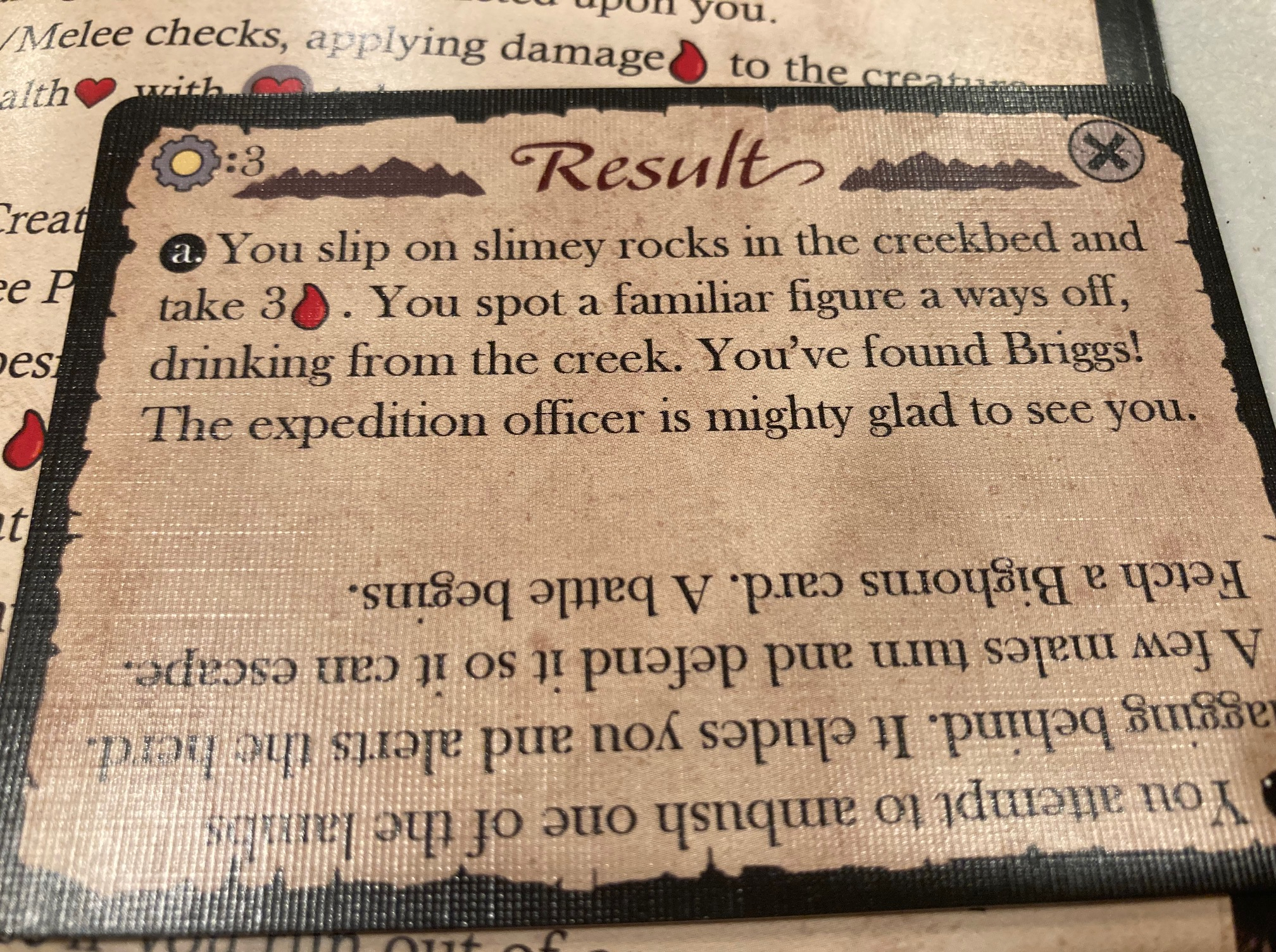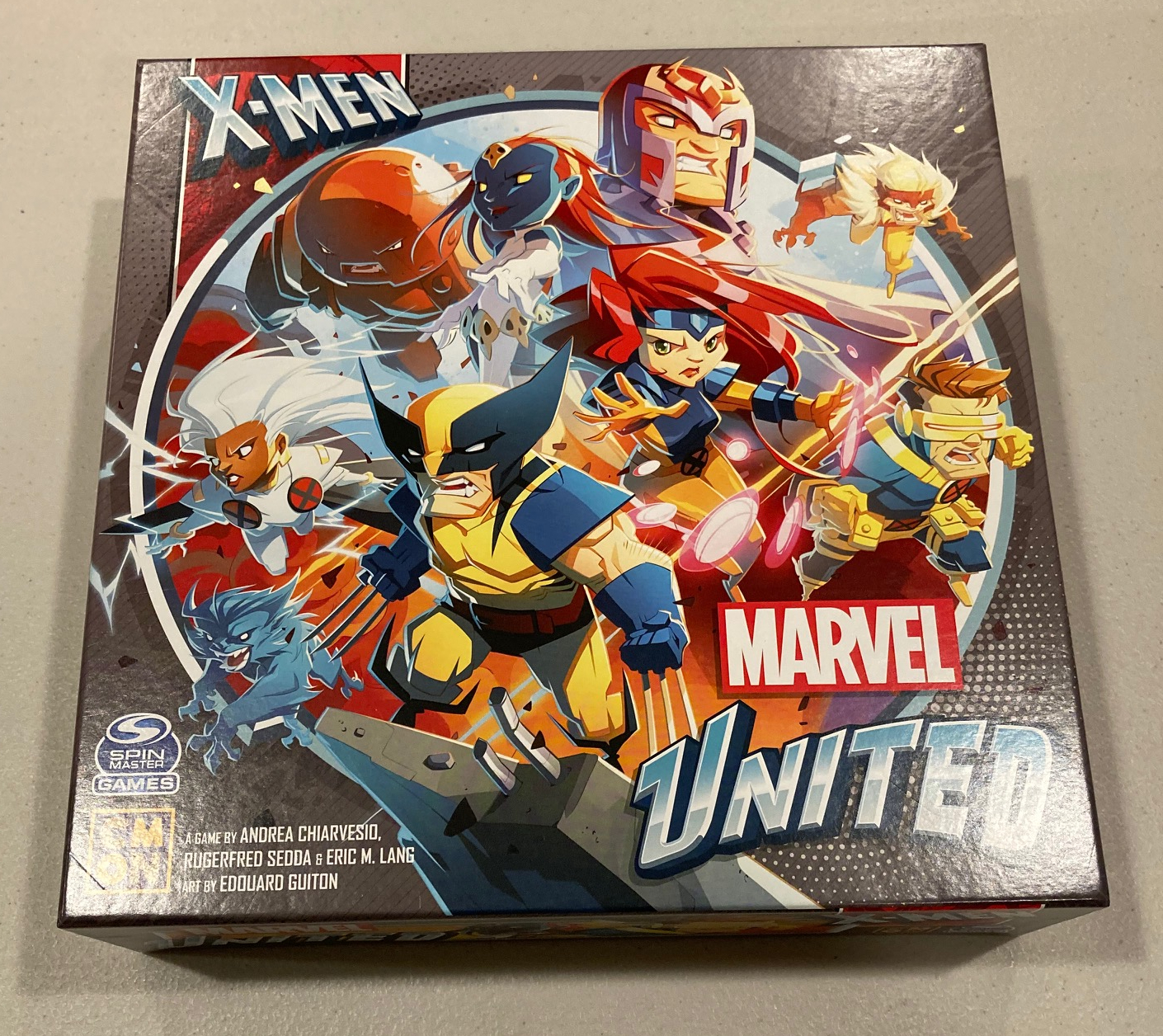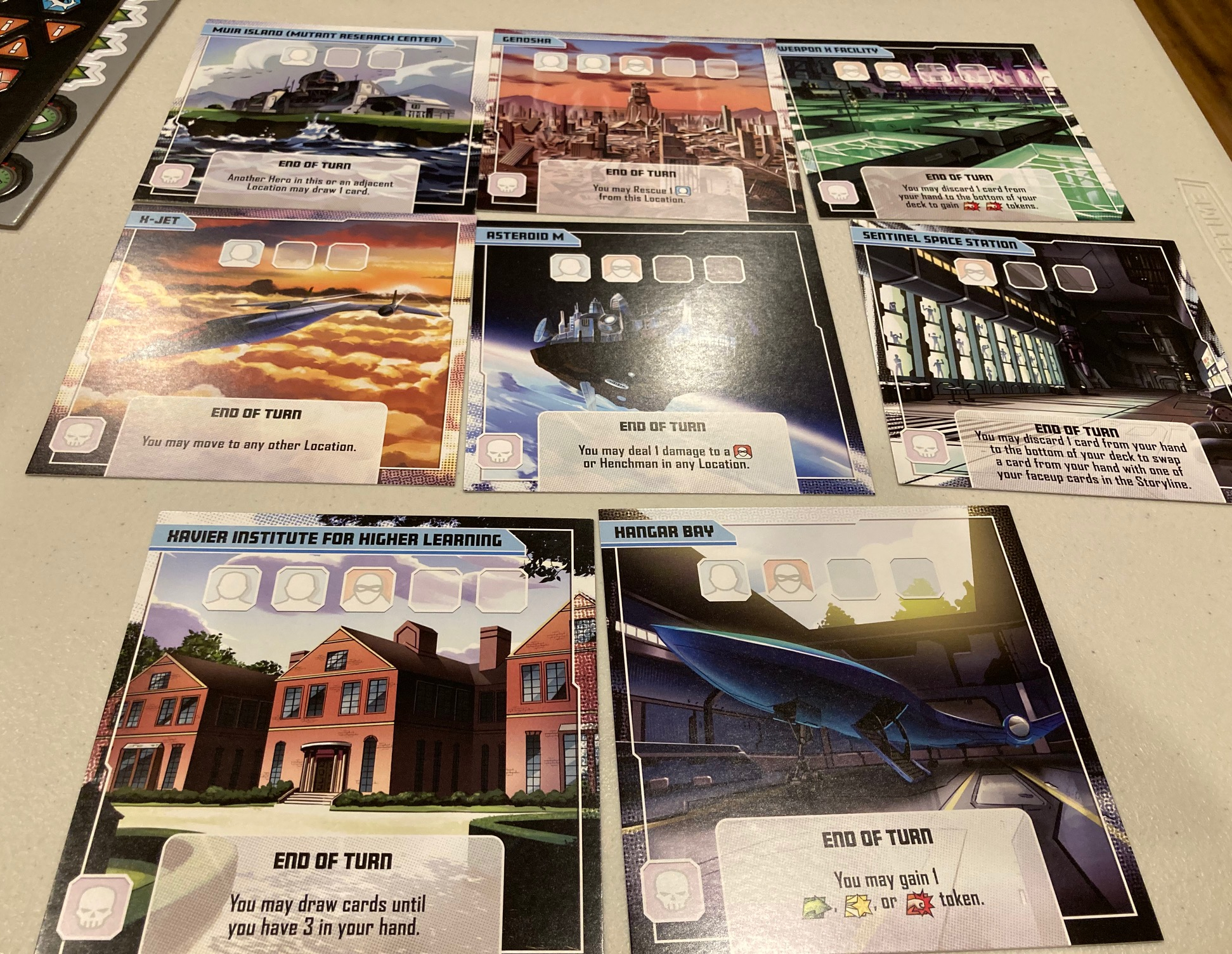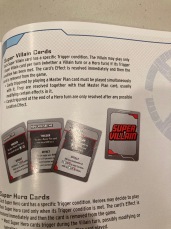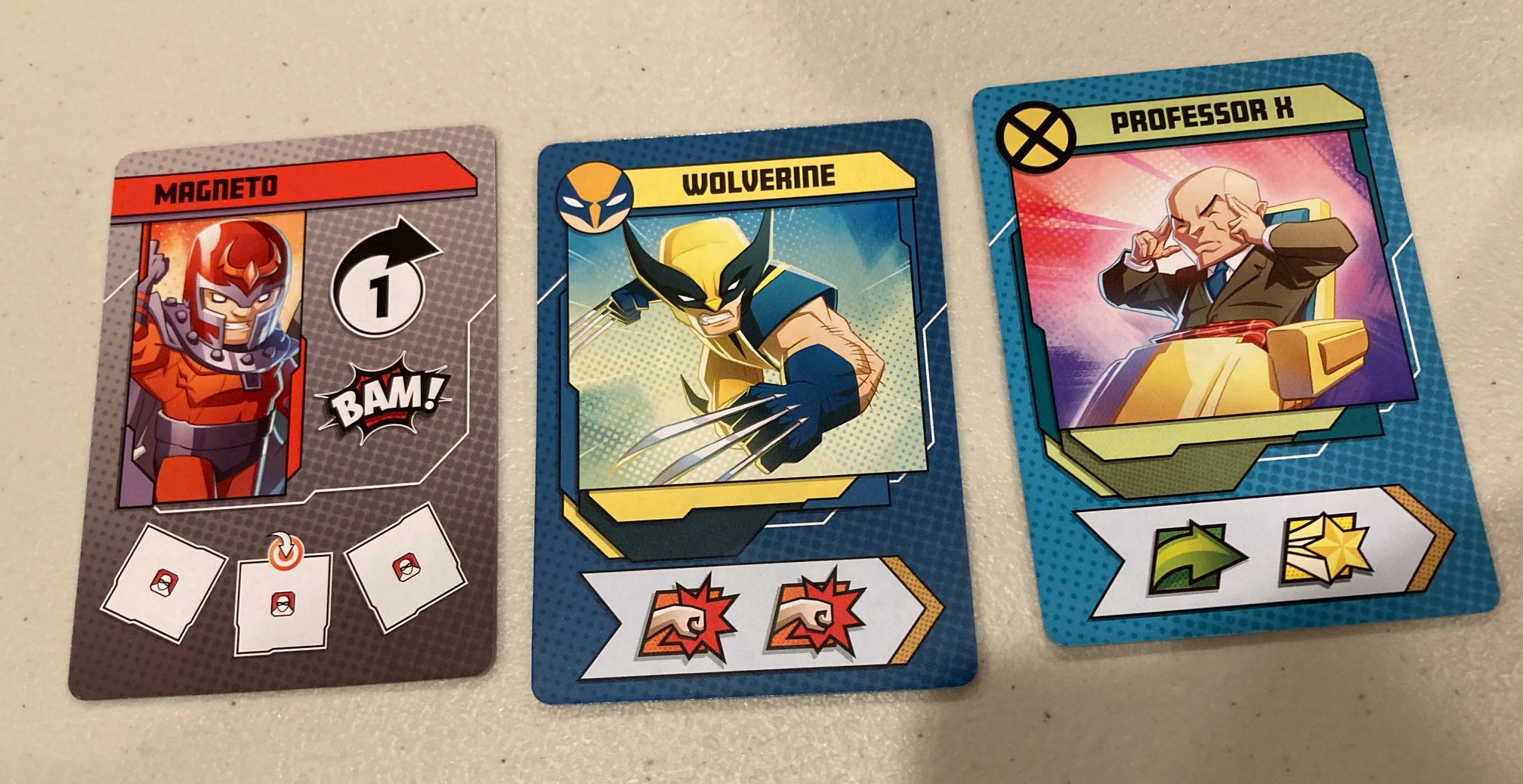Rescuing Robin Hood is a cooperative deck-builder game that came from Kickstarter. It was originally on Kickstarter back in December 2020. It delivered about 3 days ago (Oct 27th, 2021) even though it promised delivery in August 2021, but given the state of shipping today (with COVID inspired delays), 6 months late is not that bad.
Rescuing Robin Hood is a cooperative deck-builder game for 1-5 players, Ages 10+, and the playing time is 20 minutes per player. I like that the gameplay is measured per person: that feels more realistic than most games: This playtime rating was fairly accurate, if a bit undermeasured.
Although this is strictly speaking “a deck-building game” (see our Top 10 Cooperative Deckbuilders), this has a different enough feel that it’s not just a straight up copy of Dominion or games like that. Rescuing Robin Hood has its own “spin” on the deck-building genre which we’ll see below.
Unboxing and Components
The components for this game are very nice: see above! The art and art-style is all consistent with a “slightly cutesy” vibe (yet not so cute it is distracting).
The game comes with a letter from the publisher (see upper right of picture) that basically says “Thanks” and suggests that the best way to learn this game is using a you tube video. (SPOILERS! That’s how we learned the game! )

The first thing inside the box is the Character Guide (see above).

The art is that cutesy art: all the characters (villagers that you recruit) to your deck are described above.
As cool as this is to see a little “flair”, THIS IS 32 PAGE LONG and only describes the characters!!

We all kind of looked at it for a second, said “neat, but that’s too much flavor text” and tossed it back in the box. SPOILERS: I haven’t really looked at it since I opened the box. I mean, it’s cool, but it feels a little like a waste: no one is ever going to read 32 pages of backstory for the the 80 villagers!

The rulebook is next (see above). We’ll discuss it more below.
At the top were 2 sheets of cardboard tokens: the tokens are very readable, if not gorgeous. These tokens are nice and big and easy to handle (unlike the tokens in Disney Sidekicks which were so tiny). The big cardboard scene (The Big Oak) is just a place to put Villagers you will recruit (“Go wait for us by the Big Oak Tree”). (Note that I kept the Cardboard Skeletons after punch out to help keep the rulebook flat and the cards “locked” in the box: I do this ALL the time!! See here: A Defense of Keeping Punchout Skeletons)

The insert is actually quite nice and everything fits in there very well (both pre-game and post-game).
Each player will have a band of Merry Men, and the “sum” of their stats is kept track of using the tracker boards above.
Just about everything else in this game is cards: at the end of the day, this is a deck-builder.
The Villager cards (left side) are what the players decks are made of. The Sheriff’s Gards (on the right, in lue and red for medium and hard) and the enemies the Villagers are fighting in the game.

Each player takes on a “leader” role (like Maude Lindsey, left) and the final villain to fight is the Sheriff (right).

Depending on the number of players, there are some cards that describe the set-ups: the game balance is definitely achieved in how many guards you fight depending on the number of players on these cards!

The Villagers are white cards: some them can draw tokens (Thomas Cooper above gets a Scouting token when he is played).

The game gets harder as you play: note the red guards can have much higher stats (upper left of card) than the easier blue guards! If you look closely, you can also see the linen-finish as well.

This game also has really nice summary cards (see above). Once we got into the game, we found most of our questions were answered on the summary cards.

Overall, this games has great components: the art is charming and evocative and consistent. The cards are easy to read and handle. The game looks really nice out of the box!
Rulebook

This rulebook is good: easy to read and well-organized.

The first page describes the main objective of the game, and the next page jumps straight to components! Easy to read and get into.
The next few pages (see above) describe the components and the layout of the cards.

Then comes the set-up: it has (like many good rulebooks) a description and picture. See above.
Overall, the rulebook was easy to read, the fonts were large and legible, and the organization was well thought out.
We liked the ruleboook, but the truth is … we didn’t learn the game from the rulebook! We learned it from a video! I did come back and use the rulebook to learn the solo game, but when I needed to look something up in the rulebook, it seemed like it was pretty easy to find.
Good rulebook.
Solo Games

Rescuing Robin Hood comes with not one but two solo modes! Gasp! That’s right! They follow Saunders’ Law! Twice!
- Multi-Band Solo Mode: Pretty typical way to play solo, simply have the solo player play multiple characters (and play normally alternating between characters).
- Single-Band Solo Mode: Only play with one character! You don’t reset at the end of days 1 and 3, you preserve Jolly and Brawn between turns, and you “double” your stats in the final challenge (Day 5) to make-up for only having one character.
How well did they work?
Single-Band Solo Mode
The Single-Band Solo Mode is a nice way to learn a lot of the mechanics of the game. Basically, use all the set-up of a two-player game, but only take one character! Usually, every day has a lot of set-up and tear-down, but the Single Band Solo Mode simply has the single character/band keep the same set-up on days 1 and 2 (and then days 3 and 4). You learn quicker how the deck-building mechanism works in this game, and well as how the combat mechanism (fighting the guards) works, without too much set-up and tear-down. I was excited to have a single character mode …
.. until I got the end-game. Even though I only have all my stats “doubled” in the end-game, some how they seem to have forgotten that you only have two actions on your turn! In the 2-Player game, you would have 4 actions, which would “barely” be enough to win. I really believe the Single-Band Solo Mode is broken!! It seems almost impossible to win.

Maybe there is a simple house-rule (the solo player can take 4 actions on the last turn) or something like that, but it almost feels like they didn’t really playtest this mode!
This solo mode put me a in a foul mode: this felt unwinnable. I do believe this mode is broken.
However, I liked this game enough to give it another try. So, I play in the other solo mode ..
Multi-Band Solo Mode
The Multi-Band Solo Mode is a much smoother game, but it has a lot of maintenance as you play! Normally, when you play a multiplayer game, each player operates their own character, and helps with the Day to Day Maintenance. Not so here! There are a lot of cards that come out!

This makes the game “more work” as you play, but the game seems much smoother. The game does seem winnable and more fun.

Solo Mode Discussion

The Single-Band Solo Mode is broken without some house rules (the last round has 4 actions instead of 2), so I’d stay away from it. I am not quite sure what the best house rule is for balancing the Single-Band Solo Mode. I really wanted to like the Single-Band Solo Mode, because it’s a lot less work to play.
The Multi-Band Solo Mode is the way to play solo: I just wouldn’t play more than 2 characters or the Day-to-Day maintenance may become overwhelming. Even so, the solo player will be doing some work to keep the solo mode going, but it was fun.

Here’s the thing: I think the Single-Band Solo Mode might be the best way to learn the game! Maybe just chop off the fifth day? Or maybe the game could embrace the broken ness! Something like …
FOR YOUR FIRST PLAY: Have Maid Marion play as a single character using the Single-Band Solo Mode. “Maid Marion thought she could Rescue Robin Hood by herself, she even made it to the end, but when she tried … she realized she needs more compatriots!” Now that you know how to play the game, use the Multi-Band Solo Mode from now on to play!
Gameplay

This is a very simple deck-builder: you start with 8 Villager cards, and use 4 Villagers on Day 1 and then the other 4 Villagers on Day 2. Similar for Days 3 and 4. And finally, you only use 4 “choice” Villagers on Day 5!!! Depending on how many Villagers you save from the guards (see below), you and your compatriots will choose which villagers to keep and which to cull. In other words, there’s an automatic culling procedure built-in to the game.
To save a Villager, you have to defeat all the guards in front of them: See Above! There are 7 Villagers to save, each with a different number of guards in front. Every Villager you “save” goes to the Big Oak, where they will join your Merry Band on the next day (this is the deck-building part: you are making your deck of Villagers better by recruiting the ones you save).

Every time you want to defeat some guards, you can use one of three abilities: Wit (blue), Stealth (green) and Brawn(red). Wit (the blue book icon) is a push-your-luck mechanism, where you try to defeat as many guards as you can as long as your Wit is greater than the guards! Above, Amabel and Alice could together defeat the first swordsman (Wit of 4 vs 4), but if they continued to the next guard, they would lose, as the next Swordsman would add 5 more Wit to the guards.
Stealth (green), is similar to Wit, except you get to choose which guards you want sneak by. (Wit is right-to-left only).
Brawn (red) is an all-or-nothing mechanism: you turn over ALL guards guarding a Villager and you HAVE to battle them all! (Both Wit and Stealth have some measure of choosing) So, you had better hope your Villagers can take them all!
There’s also “Jolly” which is allows you to “up” your abilities by a a few. Amabel (above) gives 4 Jolly, so even if she spent all 4 to up her Wit she STILL couldn’t have defeated the final Swordman (but almost!). Jolly must be spent before the checks are made.

There are also some tokens to help out the characters: Scout allows players to look at Guards before they fight (to see if they have enough before they fight), The food tokens can be discarded to give +2 to ANY ability (or saved until next round for a +1), and finally prayer can be used to reveal and move Guards around … or two prayer can get rid of ANY guard!

The game proceeds until Day 5 when you try to Rescue Robin Hood! If you can make it into Nottingham Castle (see above), through the first and second like of guards, then you win! You save Robin Hood! If you are very lucky, you might still have enough energy to take out the Sheriff of Notingham …

Robin Hood joins you and MAYBE you can take the Sheriff (he increased all your stats by 8). Probably not … I’ve played a number of times and I have only gotten enough to even try the Sheriff of Nottingham once, and I still couldn’t do it.
First Play

My first play was a 4-Player game with on one of my game groups (then I went back and played solo). The intro letter gives a link to a you-tube video that was pretty good for teaching the game!

We watched the video, paused as we set-up, watched some more, and didn’t really need to look at the rulebook at all! I think the Summary Cards and Video were enough to teach the game! I strongly recommend using the video to learn the game! It really worked well, even though we tried a 4-Player game as our first game!

Cooperative Play
This game does a very nice job of encouraging cooperative play (mostly)! The fact that the Brawn and Jolly stats will carry on to the next player strongly encourages players to talk and try to figure out how to take out the most guards! The first few players may use Wit and Stealth to take out some guards, saving up the Brawn for a final run against the last rung of guards! It actually seemed fairly thematic as well, because Robin Hood’s Merry Men would probably opt for the attack as the final measure! It was fun to talk about how we could use our stats AS A GROUP to take out the most guards.

The only problem was that we got some analysis paralysis near the end game, and even got grumpy with each other! Although this sharing of all information was very useful, it did lead to some grumpy “analysis paralysis” moments. It was only once or twice, and mostly we had a good time playing. Just be careful of the “analysis paralysis” elephant in the room!
Too Many Cards

There were Too Many Cards and Too Much Maintenance! That 4-Player game was overwhelming! There were so many cards on the table (see above), the maintenance was daunting! (We even saw a preview of the “too many cards” problem in the Multi-Band Solo Play) My friend Andrew pointed out that he thinks this game needs to be “cut-in-half”: half the cards, half on the statistics! There were just … too many cards.
We still had fun playing, but we all felt that the number of cards, especially in a 4-Player game, seemed daunting.
We wonder if they could have tightened up the game (by “cutting it in half”) a little.
Minor Win/Major Win

Remember, you win if you Rescue Robin Hood! But, as an “optional quest”, you can go after the Sheriff of Nottingham! This would have been better phrased as “Rescuing Robin Hood is a minor win, but defeating the Sheriff is a Major Win!” Labelling it as an optional quest seemed… disenchanting. “Oh, we’ve already won, why do we have to go after him”? I would have preferred the idea of a minor win (“Ah, we saved Robin but didn’t get the Sheriff”) because it’s still a win, but it emphasizes the “we didn’t get the bad guy”.
We discussed this Minor Win/Major Win idea on the cooperative mode of Ares Expedition.
Sense of Humor
Although this is a “serious” deck-building game with real mechisms, Rescuing Robin Hood does a have a bit of sense of humor. See the cards above? How long before you can figure out the silly phrase for each? I can’t tell you how many times we just started giggling as we played. “Why are you laughing? “Get it? Dot Yoreis? Dot Your i’s”
See our Top 10 Cooperative Games With A Sense of Humor for more games with a flair for the funny.
Thoughts

This game has been in heavy rotation for the past week. Me and my group have a lot of thoughts
- It’s perhaps a little too lucky. It would nice if there were just one more mechanism to mitigate luck. Any easy House Rule would be “You can spend Jolly on a 2 to 1 conversion to add to an ability AFTER you have flipped a card!” That way, you can still mitigate a real bad card using Jolly. That would have gone a long ways towards mitigating some of the luck in the game.
- “Too Many Cards”: The game seemed balanced and it does work, but Andrew especially just wondered if you could “cut the game in half” (half the stats, half the cards) to make the game have fewer cards and less maintenance.
- The card art is very charming and Teresa especially gave it an extra point because of the art
- There’s quite a bit of math as you add up stats as you play. I didn’t have a problem with it (nor did my friends), but be aware it could be an issue. You could also look at this as a way to help people sum easily in their head …
Ratings:
- Andrew. 5.5/10 I liked it, I would play it again, but I think there were too many cards
- Sara. 6/10 I liked it and would play it again. The card art really is charming
- Teresa. 6.5/10. I liked it and would play it again. I would even suggest depending on the “mood” I was in, especially if I wanted the cute art
- Me: 7*/10. If you jettison the Single-Band Solo Mode (or make it only the first play), and add a house rule for Jolly to be spent 2-to-1 for post-card flips, it is a 7/10 for me. Otherwise, it’s probably a 6 to 6.5
Conclusion

Rescuing Robin Hood is a charming little deck-builder for 1-5 players. The art and components for the game is very evocative and fun, and the silly Villager names accentuate that fun. If you jettison the Single-Band Solo Mode (or make it the First Play) and add a House Rule to be able to use Jolly in a post-card flip, this game gets a recommendation from me. Without it, the game is a little too random and a little too frustrating, especially with all the cards and maintenance in the game.
The How to Play video (discussed in the insert and rules) for learning the game was a nice touch, and it really did teach the game well.
My friends and I had fun playing: hopefully, you know enough about this game to decide if it’s right for you or not.















